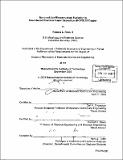| dc.contributor.advisor | Carl V. Thompson. | en_US |
| dc.contributor.author | Ross, Francis L. (Francis LaFayette), 1968- | en_US |
| dc.contributor.other | Massachusetts Institute of Technology. Dept. of Materials Science and Engineering. | en_US |
| dc.date.accessioned | 2006-03-24T18:07:44Z | |
| dc.date.available | 2006-03-24T18:07:44Z | |
| dc.date.copyright | 2003 | en_US |
| dc.date.issued | 2003 | en_US |
| dc.identifier.uri | http://hdl.handle.net/1721.1/29971 | |
| dc.description | Thesis (Ph. D.)--Massachusetts Institute of Technology, Dept. of Materials Science and Engineering, 2003. | en_US |
| dc.description | Includes bibliographical references (p. 179-181). | en_US |
| dc.description.abstract | A systematic investigation of the microstructure produced in ion-induced chemical vapor deposition (11-CVD) of copper from copper(I)hexafluoroacetylacetonatevinyltrimethylsilane (Cu(I)hfacVTMS) gas precursor is reported. II-CVD involves the ion-driven decomposition of Cu(l)hfacVTMS and subsequent deposition of copper films at ambient temperature. The thin films were grown with the aid of a broad beam Kaufman source in a "multibeam apparatus", which allowed monitoring of experimental conditions - growth rate, temperature, ion beam flux, ion beam energy and gas precursor flux. Deposition temperatures ranged from room temperature to 100⁰C. The desirable operation range is the "ion-flux-limited regime", in which sufficient precursor flux allows the growth rate to scale with the ion flux. Plan-view TEM and cross-sectional TEM (XTEM) show that the film develops a characteristic cellular microstructure of continuous crystalline copper columns (15 nm diameter) surrounded by an amorphous phase containing both carbon impurity and copper. The column diameter increases with temperature but is not affected by the growth rate for temperatures up to 60⁰C. At higher temperatures, the growth mechanism is not purely ion driven due to the onset of thermal CVD. However, quantitative XPS (x-ray photoelectron spectroscopy) shows that the film purity not only increases with substrate temperature, but also increases with decreasing growth rate due to the kinetics of byproduct desorption. STEM-EDS (scanning transmission electron microscopy - energy dispersive x-ray spectroscopy) shows that the intercolumnar spaces contain more copper at lower growth rates for a given substrate temperature. Hydrogen-atom-assisted II-CVD effectively removed all carbonaceous impurity to within the detection limit of XPS. The cellular microstructure is not observed in these films; however, deposition at 100⁰C produces films that still retain a columnar structure even though the atomic fraction of carbon is only [approximately] 0.5%. This high temperature growth process has a mixed mechanism where the ion beam flux also enhances the kinetics of the thermal CVD process. The microstructure evolution is modeled as a cellular growth process that is controlled by surface transport of carbon impurity. The cellular mechanism is corroborated by the sharp transitions | en_US |
| dc.description.abstract | (cont.) observed in XTEM for a change in deposition conditions. The surface diffusion is not only a function of temperature but also the ion flux. This explains why the column diameter remains independent of growth rate at constant temperature. The model assumes an approximately linear dependence of the diffusion constant's pre-exponential factor with ion the flux. The model predicts column diameters that are in good agreement with experimental data. The model was designed to integrate with Chiang's kinetic model to provide a foundation for depositing controlled microstructures using I-CVD. The work presented here demonstrates the possibility of growing controlled nano-cellular microstructures using a low voltage broad ion beam at or near ambient temperature. Films with such nano-cellular structures are expected to have highly anisotropic properties that could be used in a variety of applications, including magnetics ... | en_US |
| dc.description.statementofresponsibility | by Francis L. Ross, III. | en_US |
| dc.format.extent | 181 p. | en_US |
| dc.format.extent | 11220173 bytes | |
| dc.format.extent | 20225672 bytes | |
| dc.format.mimetype | application/pdf | |
| dc.format.mimetype | application/pdf | |
| dc.language.iso | eng | en_US |
| dc.publisher | Massachusetts Institute of Technology | en_US |
| dc.rights | M.I.T. theses are protected by copyright. They may be viewed from this source for any purpose, but reproduction or distribution in any format is prohibited without written permission. See provided URL for inquiries about permission. | en_US |
| dc.rights.uri | http://dspace.mit.edu/handle/1721.1/7582 | |
| dc.subject | Materials Science and Engineering. | en_US |
| dc.title | Nano-cellular microstructure evolution in ion-induced chemical vapor deposition (II-CVD) of copper | en_US |
| dc.type | Thesis | en_US |
| dc.description.degree | Ph.D. | en_US |
| dc.contributor.department | Massachusetts Institute of Technology. Department of Materials Science and Engineering | |
| dc.identifier.oclc | 54764602 | en_US |
